Balancing Preparedness and Clutter while Living Efficiently in Small Spaces
Balancing Preparedness and Clutter while Living Efficiently in Small Spaces
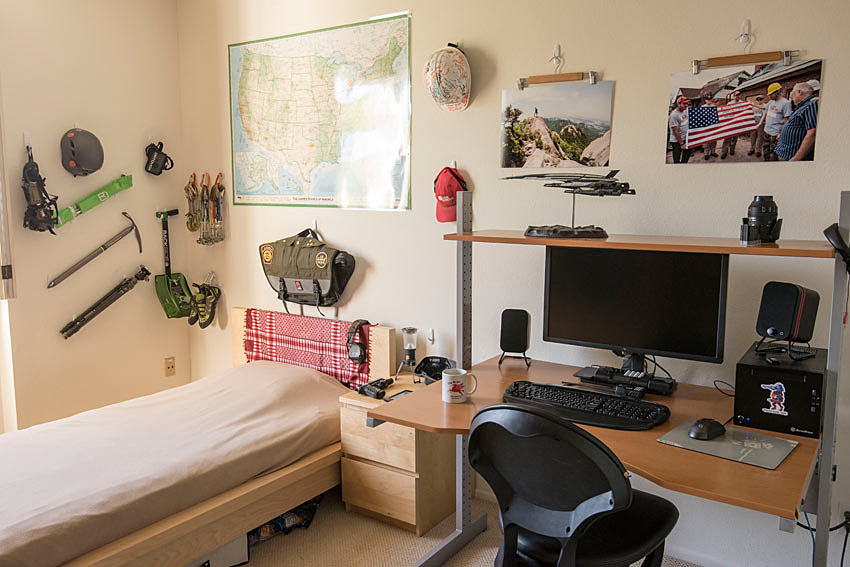
Chances are, if you’re a regular reader of ITS, you enjoy a combination of recreational shooting, camping/hiking and are at least nominally self-sufficient. Each of those alone, even in moderation, require a fair amount of storage space. ITS readers and contributors are a fairly diverse bunch and more than a few of us live in smallish spaces by necessity, or even by choice.
The living space which I rent in Los Angeles, including the bathroom, adds up to more or less 180 square feet. This is where I keep all my worldly belongings, other than my car in the garage, food/beer/water in the pantry and a humble collection of kitchen gadgets such as a cutting board and blade.
If you’ve been at this outdoor and preparedness stuff for any length of time and live in a smallish place like me, you know that piles of gear can easily get out of hand. The things we’ve accumulated that enable us to enjoy the great outdoors, plus the little extra necessitated by a nominal disaster preparedness plan, can crowd us to the point they may be a hindrance to us at home.
Quelling Material Desires
I’m not here to wax on how a life of asceticism can free our spirits to meditate the oneness and thatness of tactical nirvana; I love gear. Equipment today does more for less weight than ever before and we should be grateful to have access to magic ultraviolet wands that can produce clean drinking water.
However, I believe there’s a fine line that must be walked in our relationship with things made of molecules. A possible method of tempering your gear lust with reason and logic is to put together a weight table of your camping or backpacking gear. Remember the Scientific Method in 8th grade? Each item on your packing list is a hypothesis, each camping trip is an experiment testing that hypothesis and whether that item stays, goes or gets adapted/modified is the resulting data and conclusion.
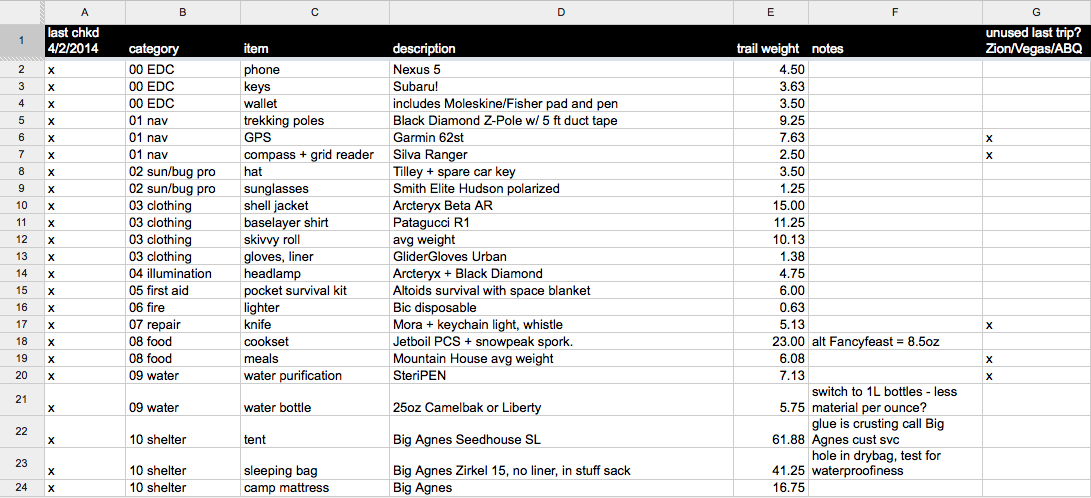
I joke with friends that the easiest way to make an earthquake kit is to go camping, then when you get home, don’t unpack. Your list of gear should allow you to survive without outside aid.
My checklist spreadsheet has columns for Date Last Packed/Inspected, Category (based on the Ten Essentials for easy sorting), Item, Description, Weight and if something was Unused on my last trip.
If there’s something on the list that gets broken, lost or I simply want a newer, lighter and shinier version of it, I make a note in the spreadsheet and add it to my Amazon Wishlist. I wait around until the 15th of every month (when the paycheck that’s not used for rent comes in) before pulling the trigger. More often than not, after a week or three of sitting in my wishlist, I cool off a bit and decide I don’t really “need” it after all. My gear purchases have decreased somewhat since I’ve implemented this system.
The last column is an indicator that something is habitually unused and should be purged in the next round of decluttering; which brings us to our next subject.
So You Want to Declutter?
There’s plenty of content out there dedicated to reducing clutter for the purposes of a simplistic lifestyle. Whether or not one ought to strive for simplicity for spiritual benefits is a personal decision, but for practical purposes, clutter hinders all of us in two ways.
First, clutter and disorganization reduce our state of preparedness. A power outage is the wrong time to find out your flashlight is dead then stumble over and rummage through your belongings trying to remember where you kept all the spare batteries.
Second, that pile of stuff you don’t want/need/love is using storage space and capital that could otherwise be reallocated to another jug of water or another case of freeze-dried meals, extending your supplies for a grid-down event another week.
Can’t decide what to purge? I made this flowchart with my personal methodology, which will hopefully give you some ideas of your own (apologies for the poor penmanship):
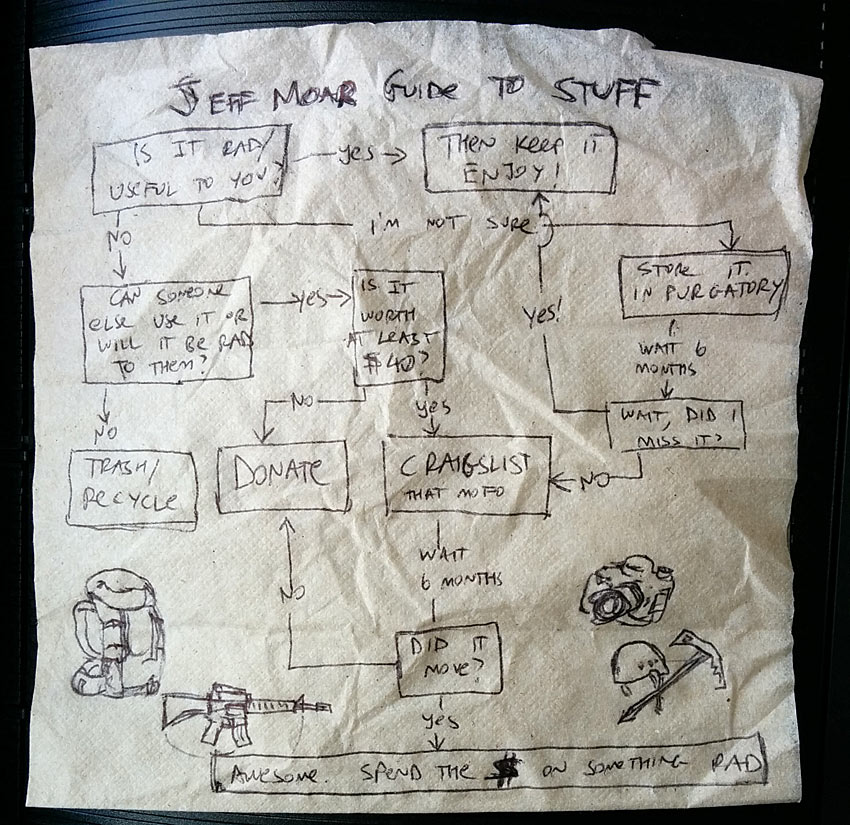
Your mileage may vary depending on the quality of your Craigslist community, but I’ve had good luck buying and selling junk on there. I admit it’s a daunting task to deal with and if it were easy, I wouldn’t have the pile of crap in my doorway the way I do now. If you’re new to the process of selling unloved/unused gear online, here’s some pointers:
1. Create a Craigslist account. It makes renewing an expiring listing as simple as a middle mouse click.
2. For photos of your gear, snap pictures with a big open window nearby with indirect sunlight coming in (side note for those starting to dabble in photography, if you were paying attention during high school Art History, this is similar to Renaissance era portrait lighting.) This gives your photos a soft, pleasing lighting.
3. Go on Amazon to get an idea for the fair used market value of your item. I like to start off listing it for $50 below the going price.
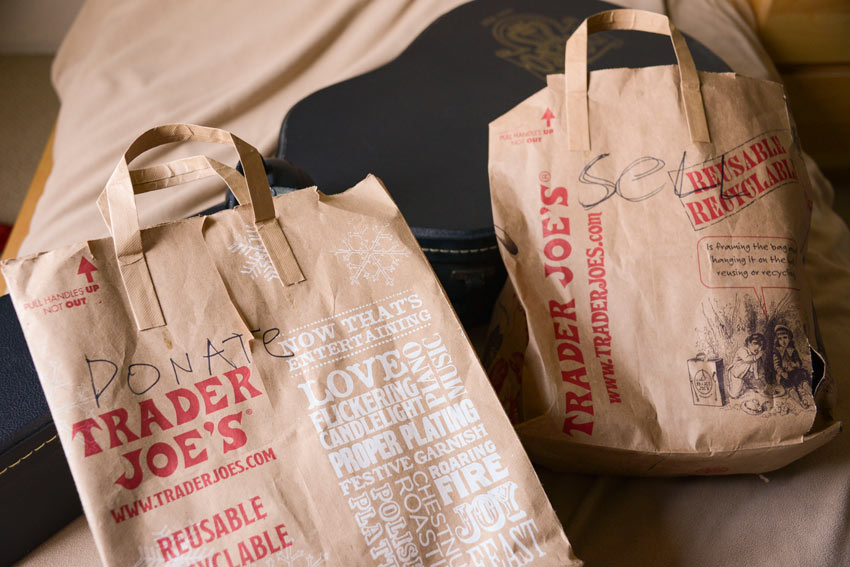
Practical Solutions for the Stuff that Stays
So now you’ve culled all that unnecessary crap, but you still have a pad full of sweet gear and it’s a tad unruly. What next?
1. Leave your bugout/roadtrip bag packed, if it isn’t already.
All that camping stuff takes up space. It’ll do you more good to not only have it in a prepared state in the form of a bugout bag, but also eliminate the hurdle of having to pack before a camping trip. Attach a luggage tag with a note of things to do and items to pack last minute. For me, these would be to pack cash in small bills, weapons and ammo, my sleeping bag which is otherwise stored in a breathable sack and uncompressed and pack my external hard drive (you’re backing up your personal data, right?) Everything else is inspected and packed in the go bag, at least in theory.
If you like to keep spares of your critical gear, consider assembling a secondary bag for your vehicle and/or for a family member.
2. Consider utilizing vertical space.
I’m testing out an over-door organizer to maintain immediate accessibility of consumables such as batteries, paracord, first aid, etc. The whole contraption can be quickly removed from the door and hastily packed into a duffel bag. Right now though, I’m leaning towards keeping critical items like handgun plus magazines and JHP ammo, batteries, cash and whatnot in my bedside nightstand. If the need arises, I know to dump everything from my nightstand into my go-bag, but if your nightstand is otherwise committed, you may want to give the over-door organizer a try.
For bulky sport-specific such as ice axes, cams and meaningful memorabilia such as old uniform items like my Smokey Bear hat, hang them up on walls. It gives your pad a ski hut vibe and items with personal stories attached to them make for more interesting conversation with guests than store-bought decor. If you’re in earthquake country, remember not to put heavy items above your bed! I use 3M Command hooks and skirt hangers as a lightweight substitute for picture frames to display prints of my photography because I’m ugly enough without shards of glass in my face.
I also have an underbed organizer, which I use to slide part of my stockpile of freeze dried food underneath my bed. This is also where I have an, ahem, ample supply of ammunition. Unfortunately, I made the mistake of buying a low-riding bed on Craigslist, otherwise I would put my entire stash of food down there. As a last resort, you can slide six 14-18 gallon plastic totes under your mattress and use that in lieu of a bedframe for very space efficient storage, but word has it the ladies find this somewhat unappealing.
3. Standardize and stock up on consumables and collect vertically not horizontally.
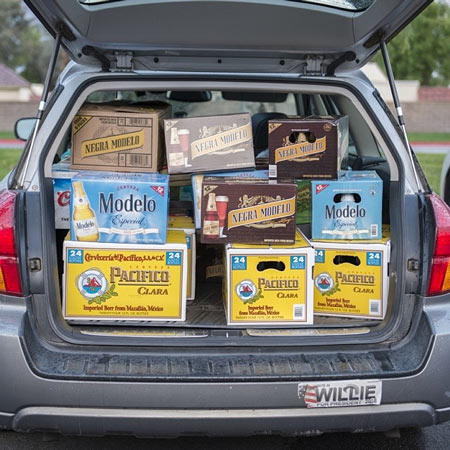 Once you’ve put the list of what you think you can or cannot survive on through the test by camping/backpacking a few times, don’t buy horizontal and spend money on superfluous gear–buy vertically and spend it on consumables for your next roadtrip or to extend your time period in which you can maintain self-sufficiency in the event the grid goes down.
Once you’ve put the list of what you think you can or cannot survive on through the test by camping/backpacking a few times, don’t buy horizontal and spend money on superfluous gear–buy vertically and spend it on consumables for your next roadtrip or to extend your time period in which you can maintain self-sufficiency in the event the grid goes down.
Consumables I recommend stocking up on:
1. Water. I like these blue Reliance 7-gallon containers. Our pals at the Art of Manliness just ran a great piece on water storage you should also check out.
2. Food. I stock up on Mountain House freeze dried meals and isobutane fuel canisters compatible with my stove system.
3. Ammunition. “You can never have too much ammo, unless you’re on fire or trying to swim.” I’ve standardized on 9mm and 5.56mm. You get extra credit if your blasters have magazine compatibility.
4. First Aid and other stuff for your personal survival kit such as bandages, matches, duct tape and paracord that tend to get used up on camping trips.
5. Hygiene items such as baby wipes, hand sanitizer and trash bags. Baby wipes replace paper towels, soap, sponge, a shower and unlike toilet paper, still function when wet.
6. Batteries: AAs and CR123s for many of us, or whatever batteries you’ve hopefully standardized all your portable electronics on. Collecting vertically, not horizontally, applies to battery compatibility too.
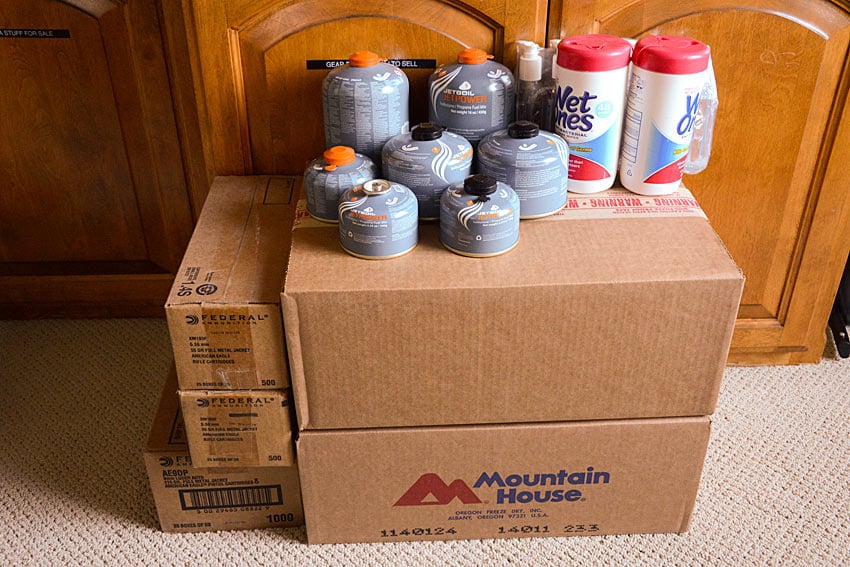
Don’t let your lack of square footage get in the way of or become an excuse to not have the sport-specific gear you need to enjoy your weekends. Nor let it prevent you from building up a supply of preparedness items you’d need if basic necessities got cut off. Remember that skills and experience don’t weigh anything or take up any space.
As I’m often on the road for various trips, there’s perpetual unpacking, sorting and repacking going on. I always seem to be trying something new to keep in check what could potentially degenerate into a mess. I think I speak for us all here when I say that we’re open to any ideas you might have. If you have specific tips, or questions, post them in the comment section below!
Editor-in-Chief’s Note: Jeff lives in Los Angeles and serves as our resident Eastern Sierra correspondent. He’s buckling down for the next Sharknado, but in the meantime is throwing the occasional blog post up on skunkabilly.com.







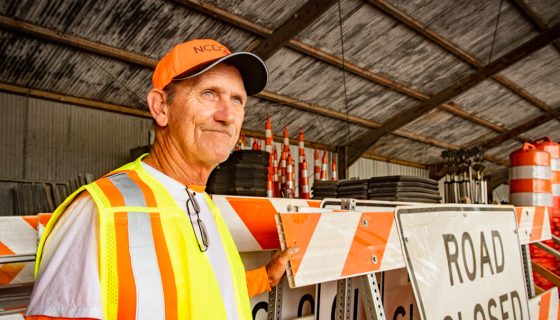

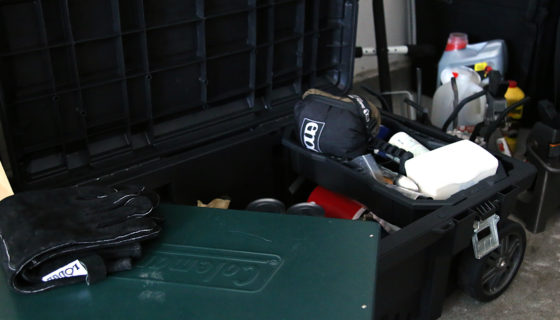

Discussion